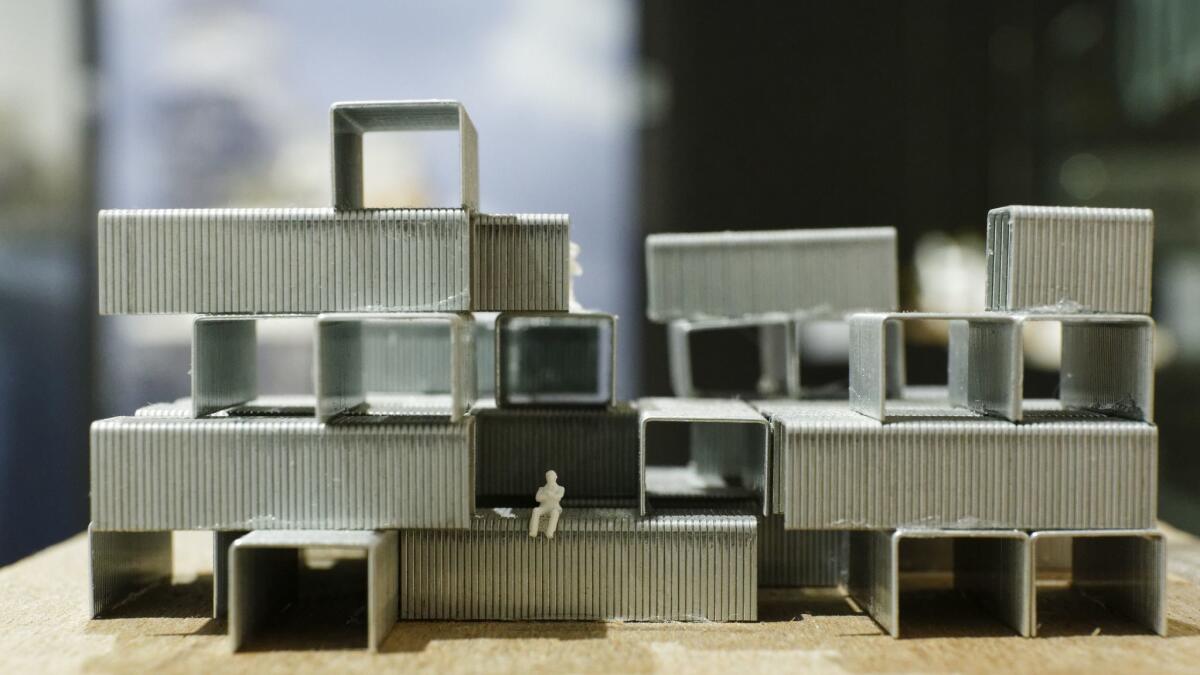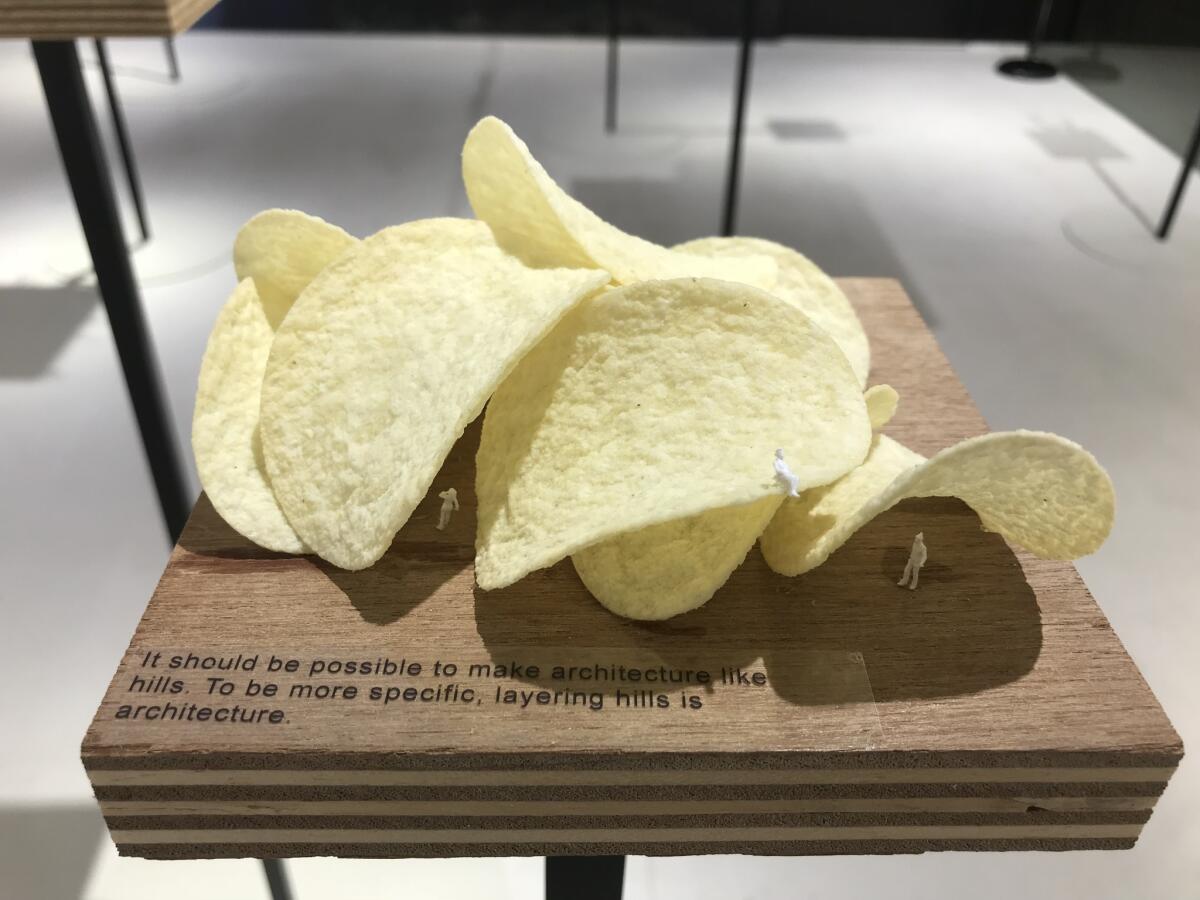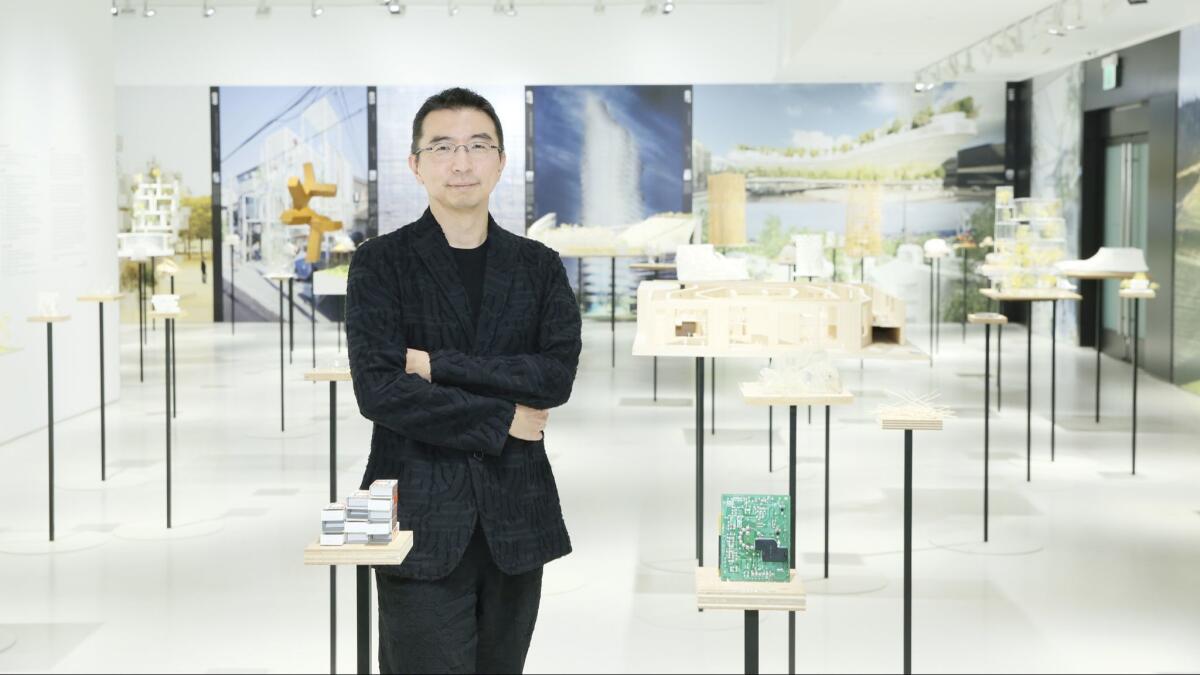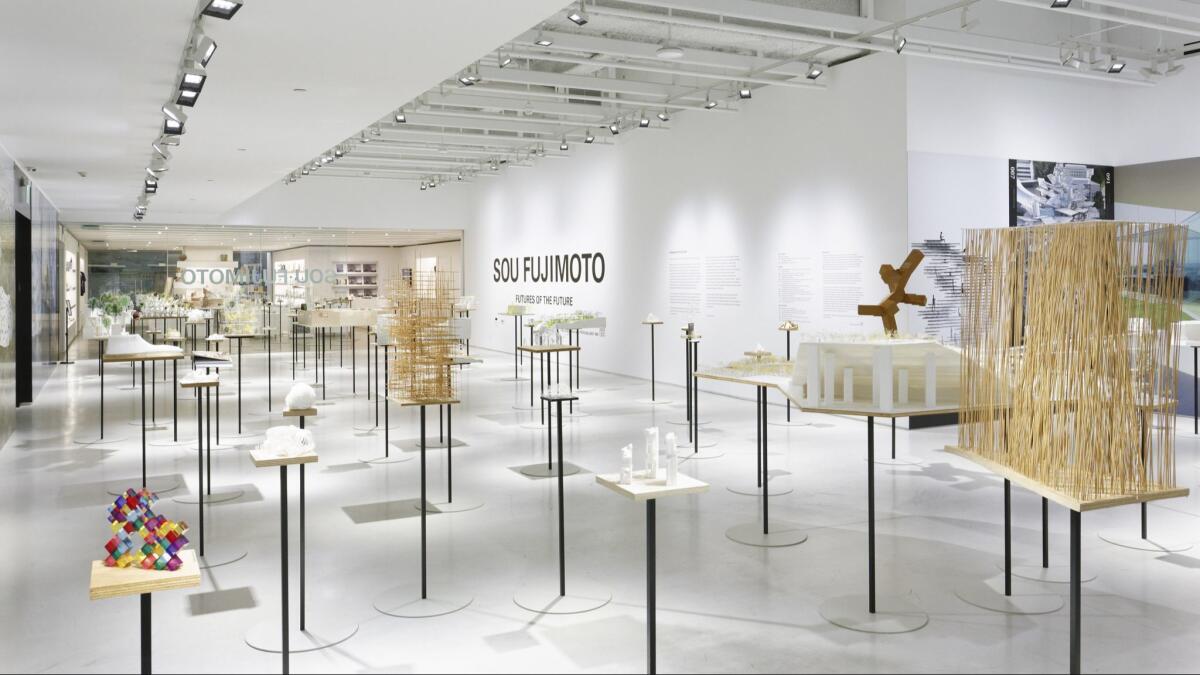With potato chips and staples, architect Sou Fujimoto sketches out his architectural ideas

- Share via
Few are the architectural models that can be eaten with onion dip. But then again, few are the architects who create experimental models quite like Sou Fujimoto.
The Japanese-born architect, now based in France, is known for designing playful buildings that draw their forms from nature, such as House NA in Tokyo, completed in 2011, whose delicate glass rooms are staggered in space, evoking branches that radiate from a tree.
Less known are the small, architectural sketches he crafts out of whatever happens to be in reach: binder clips, staple strips, an old headband, a crumpled dryer sheet and even, yes, potato chips — the latter of which he arranges in mounds and peoples with architectural figurines, producing a rough, three-dimensional sketch for what could be a space-age bandshell or outdoor pavilion.

About 100 of these whimsical models are currently on display in an intriguing exhibition at Japan House Los Angeles through Jan. 6.
The show, “Futures of the Future,” brings together some of Fujimoto’s formal architectural models from built projects, such as the stacked, pitched-roof forms of his Tokyo Apartment (made with Styrofoam in the model) and the spiraling passageways of the Musashino Art University Library (crafted from wood). It also contains dozens of his joyfully unorthodox architectural thought experiments, all made from the detritus of everyday life.
“They are doodles,” said Trast Howard, senior curator at Japan House Los Angeles. “He is trying to get people to be sensitive to architecture. That is his premise: to be inquisitive and to look at his surroundings as inspiration for future work.”
Collectively, the experimental models — part of a series dubbed “Architecture is Everywhere” — represent a dextrous ability with materials. In Fujimoto’s hands, a gray dishwashing sponge becomes the facade of a tower, an overturned glass ashtray is a rudimentary cave and the bright plastic grass that dresses up trays of take-out sushi is transformed into a miniature landscape.
“That whimsicality comes from his sense of humor,” said Howard, “but also this sensitivity to the end user, designing something in a way that humans find enjoyable.”
Each of Fujimoto’s models is accompanied by a short text, a sort of architectural note-to-self that reflects on the nature of the forms or the materials. In the plastic sushi grass, he observes an “artificial thing that imitates green might as well open the door to a new possibility of green.” Of the chips, he notes: “It should be possible to make architecture like hills.” (No architecture, however experimental, can exist without koan-like pronouncement.)

In Fujimoto’s hands, a grey dishwashing sponge becomes the facade of a tower, an overturned glass ashtray is a rudimentary cave.
Born in Hokkaido in 1971, Fujimoto’s designs are as much experiments inspired by nature as they are architectural provocations.
His first major project, in 2006, was a children’s psychiatric hospital in Hokkaido that eschewed the typical institutional profile. Instead, Fujimoto constructed an array of simple boxes strewn on a hillside that resembled a miniature city. These he connected with a series of passageways, creating a network of public and private spaces for doctors and patients — some of which faced the greenery outdoors.
“It was important to think about how I could create a comfortable residential environment,” he later said of that project. “It was really more like making house than a hospital.”
And, indeed, it is his houses that have helped raise his architectural profile. That same year, he created a wooden “house” in Kumamoto out of a series of artfully arranged beams that created a series of stacked crevices for contemplation. (Think: architectural folly meets Jenga.) Two years later, in nearby Oita, he built House N, a veritable nesting doll of geometric forms: a box within a box within a box that contained a garden in the outer band and a house at the core.
In 2011, came House NA in Tokyo, with its hovering glass boxes. In that building, said Howard, “the floor becomes furniture in some spaces.” It is “open to a diversity of use.”
In 2013, at the age of 41, Fujimoto became the youngest architect to be invited to create a temporary pavilion for the Serpentine Gallery in London (an honor previously bestowed on figures such as Oscar Niemeyer and Zaha Hadid). For that project — represented by a pair of models at Japan House — he created a white, cloud-like cage that hovered over the museum’s lawn and featured a warren of climbing and gathering spaces.
The installation, wrote critic Oliver Wainwright in the Guardian, seemed to reveal “an invisible geometric order of which the whole world is made.” It also had moments in which it seemed to dissolve into the surroundings. “On an overcast day,” noted Wainwright, “it’s hard to tell where it ends.”

Currently, the architect is at work on an apartment tower in Montpellier, France. Arbre Blanc, or White Tree, as the project is titled, is an asymmetrical structure that features a series of cantilevered balconies that evoke the scales of a pine cone. The project, said Howard, shows how “Fujimoto’s designs tend to transform as you walk through a room and see it from different angles.”
The exhibition makes no visual distinction between models from the architect’s built projects and the experimental pieces. In a way, they are all thought experiments — observations of space that function equally well as wry sculpture. A door handle is transformed into shelter. A piece of netting is made into a see-through cave. A crumpled tissue bears the text, “Is this architecture?”
Perhaps. One day it could be.

“Sou Fujimoto: Futures of the Future”
Where: Japan House Los Angeles, Hollywood & Highland Center, Level 2, 6801 Hollywood Blvd., Hollywood
When: Through Jan. 6
Info: japanhouse.jp
ALSO:
How a failed S&M magazine led Steve Kahn to create a charged photo series about a Hollywood building
In quiet yet visceral works, Zoe Leonard captures the frailty, pain and eccentricities of human life
Meet the anonymous artist installing bus benches at neglected stops on L.A.’s Eastside
Auctions, protests and controversial patrons: the three big ways art and money clashed in 2018
Sign up for our weekly Essential Arts & Culture newsletter »
[email protected] | Twitter: @cmonstah
More to Read
The biggest entertainment stories
Get our big stories about Hollywood, film, television, music, arts, culture and more right in your inbox as soon as they publish.
You may occasionally receive promotional content from the Los Angeles Times.











